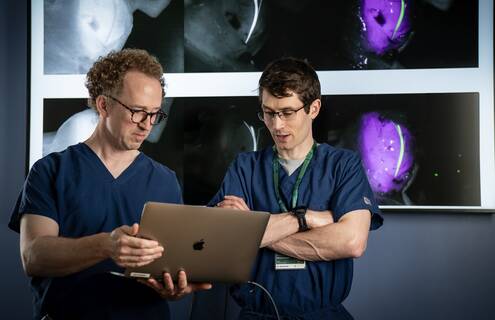
Soft-tissue cancers, called sarcomas, are difficult to clearly distinguish from healthy tissue during operations, since they often blend in. This can make surgery more challenging and sometimes means not all the cancer is removed, increasing the risk of it coming back. But what if surgeons could see cancer cells "light up" during an operation, making it easier to remove every last bit? That question is exactly what a new study published by researchers at Dartmouth Cancer Center (DCC) has answered, offering new hope for patients with soft-tissue sarcomas.
The team found that a new "glowing molecule" can highlight sarcomas during surgery, so that they can be removed more reliably, leading to higher cure rates. The study, co-led by Eric R. Henderson, MD, an orthopaedic oncology surgeon specializing in sarcoma at Dartmouth Health and DCC, showed that this special fluorescent molecule is safe and helps surgeons see cancer cells more clearly.
“In our study, the fluorescent molecule showed definitive safety and provided useful brightness in the operating room,” says Henderson. "We're working to improve the safety and effectiveness of cancer surgery to increase cure rates and minimize injury to nearby structures, especially nerves. Visually highlighting sarcomas so that they can be removed more reliably would make both of these aims possible.”
How does it work?
The molecule, called ABY-029, is designed to attach to specific proteins often found on cancer cells. Once it attaches, it glows under a special light, making the cancer cells stand out. This bright visualization in the operating room means surgeons have a clearer picture of what they're removing.
"It should change the way that we perform surgery for these tumors," Henderson explains, "both for guiding the operation itself and evaluating the removed tumor’s margins – seeing if there’s any cancer left at the edges of where we cut." This means a more complete removal of the cancer.
This pioneering research was found to be safe in patients and quickly provided useful brightness, offering a quicker and potentially more effective way to guide surgery. “It's a significant step toward more complete surgical removal of solid cancers," Henderson notes.
What's next?
The team is already working on the next steps, including fine-tuning how bright the glow needs to be to confirm that all cancer has been removed. This commitment to continuous improvement means that patients at DCC are at the forefront of new discoveries and advanced care.
“This work highlights our dedication to finding innovative ways to fight cancer and provide the best possible outcomes for our patients and community,” Henderson concludes.